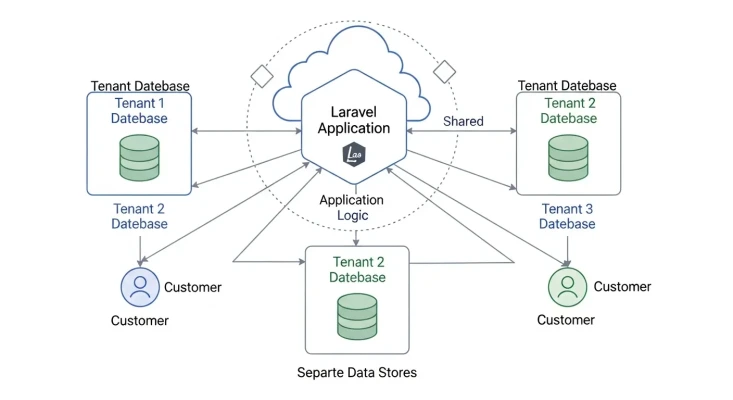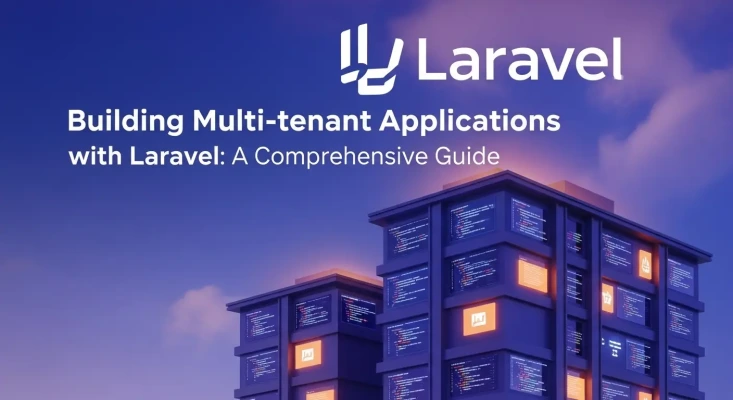Table Of Contents
- Introduction to Multi-tenancy
- Understanding Multi-tenancy Models
- Implementing Multi-tenancy in Laravel
- Popular Laravel Multi-tenancy Packages
- Best Practices for Multi-tenant Laravel Applications
- Handling Tenant-specific Customizations
- Challenges and Solutions
- Conclusion
Introduction to Multi-tenancy
Multi-tenancy is an architectural pattern where a single instance of software serves multiple customers or "tenants." Each tenant's data remains isolated from other tenants, creating the illusion that each has their own dedicated system. This approach is fundamental to most modern SaaS (Software as a Service) applications.
In essence, multi-tenancy allows you to:
- Serve multiple clients from a single codebase
- Isolate each client's data securely
- Maintain and update one application instead of many
- Scale your business more efficiently

Understanding Multi-tenancy Models
Before diving into implementation, it's crucial to understand the different multi-tenancy models:
1. Database-level Segregation
Separate Databases: Each tenant gets their own database. This provides the highest level of isolation but can increase operational complexity.
Single Database, Separate Schemas: All tenants share a database, but each has its own schema. This approach works well in database systems that support schemas (like PostgreSQL).
Single Database, Shared Schema: All tenants share both database and schema, with a tenant identifier column differentiating records. This is the simplest to implement but requires careful attention to data isolation.
2. Application-level Segregation
Domain/Subdomain-based: Tenants are identified by unique domains or subdomains (e.g., client1.yourapplication.com).
Path-based: Tenants are identified by URL paths (e.g., yourapplication.com/client1).
Request-parameter based: Tenant identification occurs through request parameters, headers, or tokens.
Implementing Multi-tenancy in Laravel
Laravel offers several ways to implement multi-tenancy. Let's explore a systematic approach:
Setting Up Tenant Identification
First, we need a mechanism to identify the current tenant. A common approach is using middleware:
namespace App\Http\Middleware;
use Closure;
use App\Models\Tenant;
class TenantIdentification
{
public function handle($request, Closure $next)
{
// Extract tenant identifier from subdomain
$host = $request->getHost();
$subdomain = explode('.', $host)[0];
// Find tenant or abort
$tenant = Tenant::where('subdomain', $subdomain)->firstOrFail();
// Store tenant in the application container
app()->instance('tenant', $tenant);
return $next($request);
}
}
Register this middleware in your app/Http/Kernel.php file:
protected $middlewareGroups = [
'web' => [
// ...other middleware
\App\Http\Middleware\TenantIdentification::class,
],
];
Database Isolation Approaches
1. Multiple Databases
For complete database isolation, you'll need to dynamically set the connection:
// In a service provider
public function boot()
{
config([
'database.connections.tenant' => [
'driver' => 'mysql',
'host' => env('DB_HOST', '127.0.0.1'),
'database' => 'tenant_' . app('tenant')->id,
'username' => env('DB_USERNAME', 'forge'),
'password' => env('DB_PASSWORD', ''),
// ...other configuration
],
]);
}
2. Single Database with Tenant Filtering
For the shared database approach, you can use global scopes:
namespace App\Models;
use Illuminate\Database\Eloquent\Model;
use Illuminate\Database\Eloquent\Scope;
use Illuminate\Database\Eloquent\Builder;
class TenantScope implements Scope
{
public function apply(Builder $builder, Model $model)
{
$builder->where('tenant_id', app('tenant')->id);
}
}
Apply this scope to your tenant-aware models:
namespace App\Models;
use Illuminate\Database\Eloquent\Model;
class TenantAwareModel extends Model
{
protected static function booted()
{
static::addGlobalScope(new TenantScope);
static::creating(function ($model) {
$model->tenant_id = app('tenant')->id;
});
}
}
Popular Laravel Multi-tenancy Packages
While you can build a custom solution, several packages can accelerate development:
1. tenancy/tenancy (formerly hyn/multi-tenant)
This robust package supports multiple tenancy models and has been a standard in the Laravel ecosystem:
composer require tenancy/tenancy
Key features:
- Database, cache, and storage separation
- Auto-identification of tenants
- Flexible tenant resolution
- Support for multiple database drivers
2. stancl/tenancy
A newer package with an elegant API and excellent documentation:
composer require stancl/tenancy
Key features:
- Automatic tenant database creation
- Data separation via multiple databases or prefixing
- Cache, queue, and storage tenant separation
- Seamless subdomain/domain identification
3. spatie/laravel-multitenancy
From the trusted Spatie team, this package offers a straightforward approach:
composer require spatie/laravel-multitenancy
Key features:
- Simple API
- Flexible tenant identification
- Database and cache separation
- Easy to customize and extend
Best Practices for Multi-tenant Laravel Applications
1. Security Considerations
- Never rely solely on filtering for data isolation
- Implement robust authorization checks beyond tenant identification
- Use Laravel's Policy system to enforce tenant boundaries
- Regularly audit database queries to ensure they include tenant scoping
2. Performance Optimization
- Consider caching heavily-accessed tenant data
- Use database indexes on tenant identifier columns
- Be mindful of N+1 query issues in tenant-scoped relationships
- Consider sharding strategies for very large multi-tenant applications
3. Testing Multi-tenant Applications
Create dedicated test cases for multi-tenancy:
class TenantTestCase extends TestCase
{
protected $tenantA;
protected $tenantB;
protected function setUp(): void
{
parent::setUp();
$this->tenantA = Tenant::factory()->create();
$this->tenantB = Tenant::factory()->create();
}
protected function actingAsTenant($tenant)
{
app()->instance('tenant', $tenant);
return $this;
}
}
Test isolation between tenants:
public function test_tenants_cannot_see_other_tenants_data()
{
// Create data for tenant A
$this->actingAsTenant($this->tenantA);
$resourceA = Resource::factory()->create();
// Switch to tenant B and verify data isolation
$this->actingAsTenant($this->tenantB);
$this->assertDatabaseMissing('resources', ['id' => $resourceA->id]);
}
Handling Tenant-specific Customizations
For SaaS applications, tenants often need custom features:
Dynamic Configuration
Store tenant-specific configuration in the database:
// Access tenant configuration
$value = app('tenant')->configuration->where('key', 'setting_name')->first()->value;
// Or with a helper
function tenant_config($key, $default = null) {
$config = app('tenant')->configuration->where('key', $key)->first();
return $config ? $config->value : $default;
}
Feature Flags
Implement tenant-specific feature toggles:
if (app('tenant')->hasFeature('advanced_reporting')) {
// Show advanced reporting features
}
Challenges and Solutions
Data Migration Between Tenants
When moving data between tenants:
// Example tenant data migration
public function migrateUser(User $user, Tenant $fromTenant, Tenant $toTenant)
{
DB::transaction(function () use ($user, $fromTenant, $toTenant) {
// Create a new user in destination tenant
$newUser = $user->replicate();
$newUser->tenant_id = $toTenant->id;
$newUser->save();
// Migrate related data
foreach ($user->orders as $order) {
$newOrder = $order->replicate();
$newOrder->tenant_id = $toTenant->id;
$newOrder->user_id = $newUser->id;
$newOrder->save();
}
});
}
Handling Shared Resources
Some resources may need to be shared across tenants:
class SharedResource extends Model
{
// No tenant scope applied to this model
}
class TenantResource extends TenantAwareModel
{
public function sharedResource()
{
// Relationship to a shared resource
return $this->belongsTo(SharedResource::class)->withoutGlobalScope(TenantScope::class);
}
}
Conclusion
Building multi-tenant applications with Laravel offers tremendous flexibility and power. By carefully choosing your architecture and leveraging the right packages, you can create scalable SaaS applications that effectively serve multiple clients while maintaining data isolation and security.
Remember that the best approach depends on your specific requirements:
- Use separate databases for maximum isolation
- Use schema separation for a good balance of isolation and simplicity
- Use row-level filtering when operational simplicity is paramount
Whichever approach you choose, Laravel's ecosystem provides the tools to build robust multi-tenant applications efficiently.
SEO Keywords: Laravel multi-tenancy, multi-tenant SaaS application, Laravel tenant isolation, database multi-tenancy, multi-tenant architecture, Laravel SaaS development, tenant identification middleware, Laravel tenant packages, stancl/tenancy, spatie/laravel-multitenancy
SEO Description: Learn how to build scalable multi-tenant applications with Laravel using different isolation strategies, middleware for tenant identification, and popular packages like stancl/tenancy and spatie/laravel-multitenancy.


Add Comment
No comments yet. Be the first to comment!